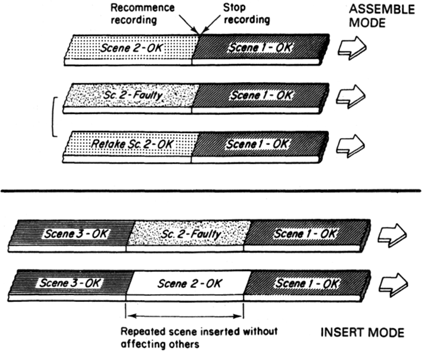Using Videotape
Videotape recording facilities have transformed television production.
Principles
• Picture. All types of VCR/VTR use a helical scan method of recording the color picture. However, their technicalities vary, and the present 15 or so different formats are incompatible, and so will only handle tapes recorded on their own particular system.
• Audio, All systems record the sound simultaneously on the tape (in mono or stereo). Some have a soundtrack along the tape edge; others also use special ‘depth multiplex’ Hi-Fi audio tracks, recorded along with the video tracks.
Editing the videotape
When film is edited, sections are selected, cut out and spliced together into the required order. Videotape must not be cut. It would not only permanently damage the tape, but would upset picture and sound at that point.
Instead, videotape is edited by re-recording chosen sections from the original 1st generation master tape. There are two main disadvantages to this copying or ‘dubbing’ process. With most videorecording formats (except digital systems), picture and sound quality deteriorate a little in the copy (2nd generation). If you then make a copy of that copy (3rd generation), degrading becomes more noticeable (picture noise, smearing, lower color fidelity, etc.) and so on. Secondly, copying involves changing cassettes, and shuttling to and fro to selected sections; a time consuming process.
The editing process
Although you can edit in camera by starting/stopping recording while shooting, it is preferable to simply record sequences, and leave all editing until later.
There are two basic methods of editing, each with advantages and drawbacks:
• In assemble (assembly) editing, you add new material on the end of the previous sequence.
• In insert editing, you add new material within an existing recorded sequence. Off-line editing. The first stage in VT editing is to take a copy of the original videotape which includes a timecode display at the bottom of the picture, showing when each moment was recorded. Running this tape, the director or editor notes the points at which required sections begin and end. This edit decision list is used to guide the actual editing mechanics.
On-line editing. The source tapes are loaded on replay VCRs/VTRs, which are connected to an edit controller. Depending on its design, this device, guided by the edit decision list, rolls the machines to the selected sections, and copies them in order (with the appropriate transitions) onto an edit recorder VCR. The sound on the original videotapes can be copied ‘straight’, or lifted off’, prepared separately, and ‘layed back’ as a new soundtrack.

Time code
During videotaping, exact data is recorded that allows every instant to be identified. This is used for cuing and editing. The time code can be displayed within the picture, or read out on a separate indicator.

Videotape editing
Assemble mode: A further scene can be added to an existing recording; to replace a faulty shot, or add new material.
Insert mode: Here the new material is recorded within the recording. This method avoids interrupting the system’s synchronizm (control track pylses).
